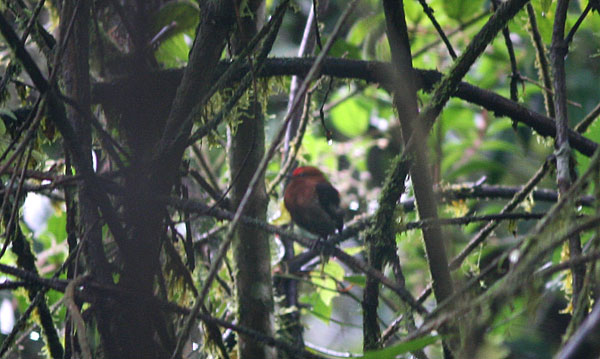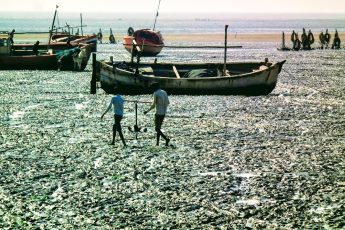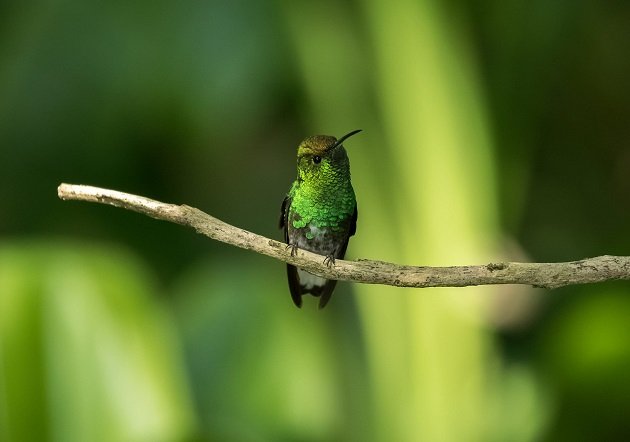The third day of my Ecuadorean odyssey in the able care of Renato and Paola of Pululahua Hostal was our unofficial Chocó Endemics day. The Chocó Region is an Endemic Bird Area that encompasses 100,000 square kilometers of varied habitat in western Colombia and Ecuador. With its profusion of humid, wet, and super-wet forests, the Chocó region is considered one of the wettest regions on dry land. As we all know, water means life, and in this case, an explosion of species diversity that has resulted in plenty of exciting bird species found nowhere else on Earth.
As one proceeds west from the Ecoruta along the Quito-Calacali-Esmeraldas highway, elevation drops from a lofty but still modest by Ecuadorean standards 2000 meters down to below 300 meters. Each incremental decrease in elevation introduces an almost entirely new suite of birds. Consequently, birders in the Chocó Region cover a lot of ground.
When Renato and I were planning our blitzkreig itinierary, I agonized about this specific leg of our trip. The Mindo Cloudforest Foundation (MCF), a staunch and highly effective supporter of Ecuadorean avian conservation and ecotourism, makes the decision process pretty tough. Down at around 300 meters lies their Rio Silanche Bird Sanctuary, 200 acres of primary and regenerating lowland forest and former plantaion land. Further east on the other hand is Milpe Bird Sanctuary, a steep, forested river valley that covers an altitudinal range from 1020-1150m.
Both MCF sanctuaries shelter important Chocó endemics. Unfortunately for the time-pressed traveler, they offer different options. Rio Silanche is home to Chocó species one would normally have to trek to Esmeraldas or Colombia to see, beauties like Purple-chested Hummingbird, Double-banded Graytail, Griscom’s Antwren, Stub-tailed Antbird, Black-tipped Cotinga, Slate-throated Gnatcatcher, Scarlet-breasted Dacnis, Scarlet-and-white Tanager, and Blue-whiskered Tanager. Milpe Bird Sanctuary presents other equally attractive endemics like Plumbeous Forest-Falcon, Club-winged Manakin, Long-wattled Umbrellabird, and Glistening-green Tanager. El Milpe is also deemed the easiest place in the world to find the elusive Moss-backed Tanager, a species which somehow captured my imagination above the others.
After much internal debate and aggressive comparisons of the site lists, I felt good about Renato’s recommendation of El Milpe. I just wanted to see a Moss-backed Tanager. In the end, this hand-wringing over which sanctuary would yield the most endemics was entirely academic; the trip to Milpe Bird Sanctuary was washed out! As wet as Mangaloma was, El Milpe was infinitely worse to the extent that we simply could not see birds. Disaster!
Believe it or not, all was not lost. Renato was confident that, even in the midst of the monsoon, he could lead us to the lek of the coveted Club-winged Manakin. To my amazement, he was as good as his word, finding the exact torrent-tossed thicket in which cowered a gorgeous male manakin. One more Chocó endemic down!

Club-winged Manakin
With massive regret, we had to leave El Milpe. Apart from the manakin, some bedraggled hummingbirds, and a sole, soaking wet American Redstart, the local birds were all tucked in until the storm passed. What a shame. Milpe Bird Sanctuary is a world-class refuge and another of Ecuador’s admirable conservation triumphs. Next time, I’ll take my time so I don’t have to choose between MCF sanctuaries.





 New writers welcome – please contact us for details.
New writers welcome – please contact us for details.

















I recently stopped at Milpe and to my surprise the Club-winged Manakin could only be heard. Apparently he is tired of performing his song and dance and has moved to more private quarters. Let´s hope this little guy does not decide to move permanently; this would be a disaster for Milpe. For now his song could be heard at a distance and we could only imagine his skirt lifting dance of passion.
Too bad for the Moss-backed Tanager, Bangsias are really spectacular birds… in the other hand, Club-winged Manakins are great!
I’m so sorry to hear that you got washed out at Milpe! I have had my fair share of El Choco precipitation in that area so know how that can feel. Thanks for blogging about it anyways though- always great to hear about birding in Ecuador. On a side note, that American Redstart is an interesting record for June!
Renato, that’s a shame. I hate to imagine my mood had the manakin been a no-show that day!
Jan, I agree and tend to favor tanagers over manakins.
Patrick, I should have clarified that this trip was in January. Still, to my knowledge, American Redstart is not a common sighting in Milpe. BTW, I’ll be in your approximate part of the world this weekend as I spend a week at the Canopy Tower and Canopy Lodge in Panama.